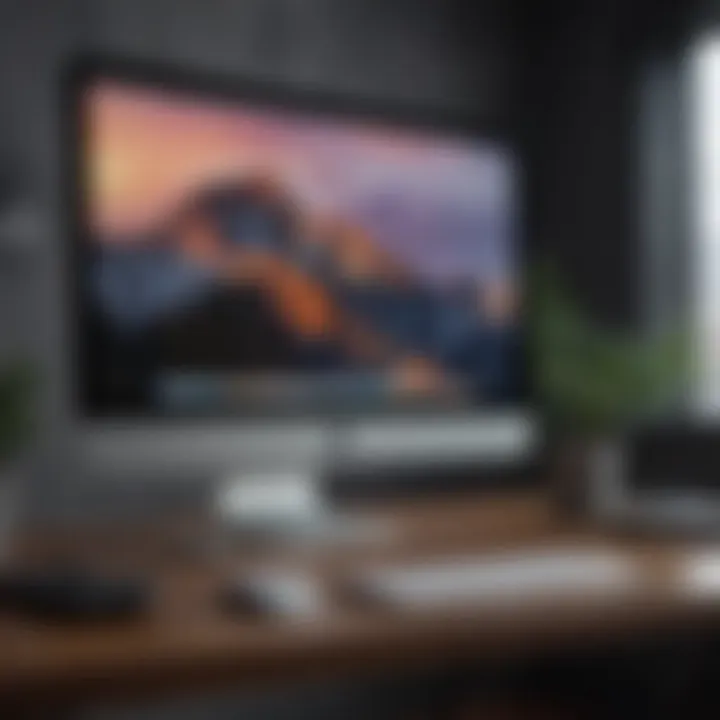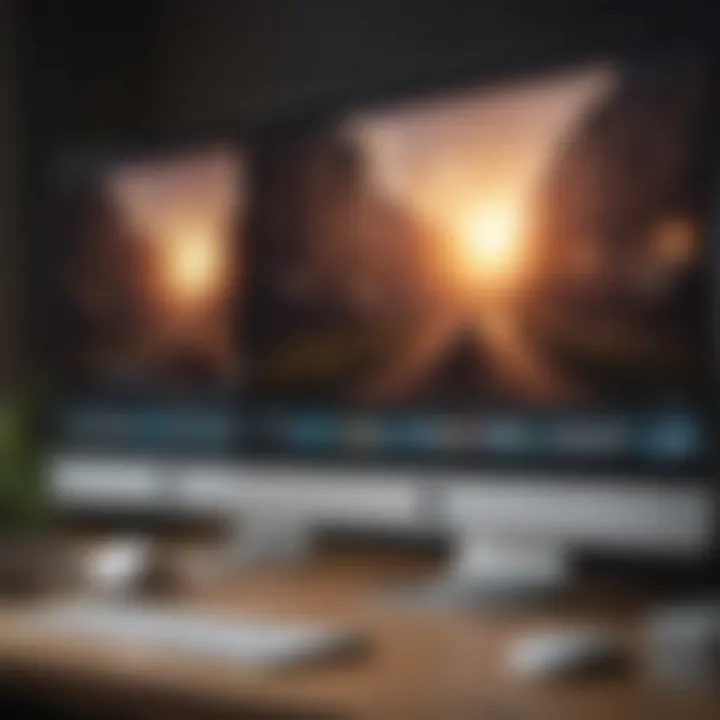Mastering Your MacBook: A Comprehensive Monitor Setup Guide


Intro
Setting up an external monitor for your MacBook can transform how you work and interact with your device. The capacity to extend your workspace or mirror your display enhances productivity significantly. As you navigate through this guide, you will discover the essentials of hardware requirements, methods for connection, and necessary software configurations. This information is crucial whether you’re a designer requiring extra screen space or a business professional looking to elevate your workflow.
In the following sections, we will cover such topics in depth: the necessary products and their specifications, the design aspects of these monitors, their performance and user experience, and troubleshooting tips. By the end, you will be equipped with all the knowledge needed for an effective MacBook monitor setup.
Understanding the Need for an External Monitor
Setting up an external monitor for your MacBook is not just a technical enhancement; it’s a strategic improvement in your workflow and productivity. The need for an additional screen arises from various functional and ergonomic perspectives. An external monitor enhances visibility and workspace, leading to improved efficiency in daily tasks. Instead of squinting at a smaller screen, having a larger display can alleviate eye strain and allow for more detailed work.
Moreover, working with a bigger screen facilitates multitasking. You can have multiple windows open side by side, reducing the constant need to toggle between applications. This ability can prove vital for developers, designers, or anyone involved in intensive data work. The right setup can promote a more organized work environment, creating a platform for better focus and clarity.
"Adding an external monitor to your MacBook is about transforming your workspace into a more productive haven."
In contemporary work routines, where remote working and digital collaboration are prevalent, having extra screen real estate stands out. It allows for seamless video calls while managing presentations, documents, or design software concurrently.
Benefits of Extending Your Screen
Extending your screen serves numerous practical benefits. First, it increases productivity by removing barriers to accessing data. This helps particularly in fields like programming or graphic design where constant switching between applications can be a distraction.
In addition, a larger screen can improve resolution and color accuracy. Designers will appreciate this, as the refined visuals allow for more precise adjustments. Moreover, professionals can take advantage of the larger working area, which is crucial for detailed tasks like editing videos or spreadsheets. Here is a summary of the benefits:
- Better multitasking capabilities.
- Reduced eye strain from smaller displays.
- Improved attention and focus with less distraction.
- Increased comfort during long hours of work.
When to Consider Multiple Displays
Not every user needs multiple displays, but several scenarios indicate when it's essential. Professionals who handle diverse projects with numerous applications can find it beneficial. For instance, writers can manage their research material and writing software without constantly switching.
If you often participate in video conferencing while needing access to other tools or files, dual displays can facilitate smoother interactions. Likewise, if your job involves presenting data analysis, having a second monitor can be invaluable for showing your work while conducting a discussion.
Deciding to implement multiple displays should depend on personal workflow needs. Consider whether you regularly find yourself needing additional screen space or if your tasks can be better managed with enhanced visibility. This choice can greatly affect productivity and overall work satisfaction.
Choosing the Right Monitor for Your MacBook
Choosing the right monitor for your MacBook is a crucial step in enhancing your overall productivity and user experience. The monitor significantly influences how you interact with your device, whether for work, leisure, or creative projects. A well-selected monitor can improve visual clarity, increase workspace, and streamline workflow. Here are the specific elements and considerations that are essential in this selection process.
Specifications to Look For
Resolution
Resolution refers to the number of pixels displayed on the screen, influencing the clarity and detail of visuals. Common resolutions include Full HD, 2K, and 4K. For MacBook users, a 4K resolution can be particularly beneficial.
The resolution ensures that text is sharp and images are vivid, improving the accuracy of work especially in design or photo editing. Higher resolutions also allow more applications to be visible at once, leading to a more efficient multitasking environment. There can be some drawbacks, like the need for a more powerful graphics card or potential scaling issues with less optimized software.
Panel Type
The panel type, such as IPS, TN, or VA, affects color accuracy and viewing angles. An IPS panel is often the best choice for MacBook users because it offers superior color reproduction and wider viewing angles. This characteristic is especially important for creative professionals who rely on precise colors.
However, IPS panels can be more expensive than TN panels, which means weighing budget against quality is vital. Each type also has its contrast and response time characteristics that may affect how certain content appears on screen.
Refresh Rate
The refresh rate describes how many times per second a monitor updates the image, usually measured in hertz (Hz). While most users find 60Hz sufficient for daily tasks, those engaged in gaming or video editing might prefer higher rates, like 120Hz or 144Hz.
A higher refresh rate allows for smoother motion and less blurring, greatly enhancing the experience during high-frame-rate videos or fast-paced gaming. But again, higher specifications may lead to a more costly choice, which can deter budget-conscious buyers.
Recommended Monitors for MacBook
When browsing for monitors compatible with MacBook, certain models stand out due to their features and reliability. Popular choices include:
- LG UltraFine 5K: A leading choice for Mac users, known for its stunning resolution and color accuracy. It complements the Mac ecosystem very well.
- BenQ PD3220U: This monitor is designed with designers in mind, offering excellent color accuracy and a range of connection options.
- Dell UltraSharp U2720Q: This model is a strong contender, providing both 4K resolution and good build quality, ideal for everyday use.
In summary, selecting the right monitor involves evaluating specifications such as resolution, panel type, and refresh rate. By understanding how these components impact usability, users can make informed choices that enhance their MacBook experience.


Hardware Connections for MacBook and Monitor
Setting up an external monitor for your MacBook involves understanding the various hardware connections available. Getting this right is crucial to enhance your productivity and user experience. The right connection type can affect display quality, refresh rates, and overall efficiency. As you set up your dual-screen workspace, the connection choice must cater to your specific needs and the capabilities of your devices.
Types of Connections
HDMI
HDMI, or High-Definition Multimedia Interface, is one of the most prevalent connections available for external monitors. The key characteristic of HDMI is its ability to transmit both video and audio signals through a single cable. This feature makes it a popular choice for users who want a simple and efficient setup. HDMI supports high resolutions and refresh rates, making it suitable for a variety of tasks, from professional design work to standard office applications.
Advantages
- High compatibility with most monitors and TVs.
- Supports high-definition video and audio.
- Easy to use with plug-and-play functionality.
Disadvantages
- Limited cable length for optimal signal quality.
USB-C
USB-C is gaining traction as a forward-thinking connection method. Its key characteristic is its reversible design, which allows for easy plugging in. USB-C stands out for its versatility; it can handle data transfer, audio, video, and even power delivery. This makes it a beneficial option, especially for modern MacBook models which come equipped with USB-C ports. Users can connect a monitor while also charging their devices, streamlining the setup.
Advantages
- High-speed data transfer rates.
- Capability to power peripherals along with data transmission.
- Universal connectivity for many devices.
Disadvantages
- Requires specific cables that may not be widely available.
- Compatibility concerns with older monitors.
Thunderbolt
Thunderbolt technology is regarded as the fastest connection option available. Its key characteristic is its ability to support multiple protocols, which means it can connect several devices simultaneously. Thunderbolt also enables high resolutions and refresh rates, making it ideal for tasks requiring intensive graphics performance. It is particularly popular among professionals in creative fields, such as video editing and graphic design, who need minimum latency and maximum quality.
Advantages
- Extremely high data transfer speeds.
- Supports daisy-chaining multiple devices.
- Excellent for high-resolution displays.
Disadvantages
- Generally, more expensive cables and equipment.
Using Adapters and Dongles
In cases where your MacBook's port type does not match the monitor's connection type, adapters and dongles can bridge the gap. Here are a few key points about their use:
- Compatibility: Ensure that the adapter you choose supports the required standards for both your MacBook and the monitor.
- Quality: Low-quality adapters can result in reduced video quality, so it is best to invest in reputable brands.
- Convenience: Some adapters also feature additional ports, providing extra functionality.
It is essential to choose the right connection and adaptors that suit your specific needs. As technology evolves, staying informed about the latest options can help you optimize your setup.
Setting Up Your External Monitor
Setting up your external monitor is a pivotal step in maximizing your MacBook's functionality. Connecting an external monitor can significantly improve your workflow. It enhances your visual workspace, allowing for better multitasking and productivity. Furthermore, correctly setting it up will ensure you are not just using more screen real estate, but actually leveraging it efficiently.
This section discusses the fundamental process of establishing an external monitor connection. It also delves into configurations you can apply in macOS. These setups offer practical benefits. With a thoughtful arrangement of displays, you can minimize the time spent switching between windows and applications. This efficiency can lead to a seamless work environment where tasks are handled with ease.
Initial Connection Steps
To start with, you must establish a physical connection between your MacBook and the external monitor. This process generally follows a few key steps:
- Identify Connection Type: First, recognize the type of ports available on your MacBook and the monitor. Common options include HDMI, USB-C, and Thunderbolt.
- Select the Right Cable: Choose the appropriate cable that corresponds with these ports. For instance, if your MacBook has USB-C, but your monitor utilizes HDMI, you will need a USB-C to HDMI adapter.
- Power On Both Devices: Ensure that your MacBook and the monitor are powered on. This is crucial for the systems to recognize each other.
- Connect the Cable: Plug one end of the cable into the MacBook and the other into the monitor.
- Switch Monitor Input Source: On the monitor, use the menu buttons to select the correct input source that matches the connection you’ve used.
These straightforward steps can seem simple, but they lay the foundation for your external monitor setup.


Configuring Display Settings on macOS
Once the physical connection is in place, the next crucial task is to configure the display settings in macOS. Correct configurations can ensure an ideal experience:
- Access System Preferences: Click on the Apple logo in the top-left corner of your screen and choose 'System Preferences'. Then, select 'Displays'.
- Arrangement Tab: Here, macOS presents you with an arrangement of your connected displays. You can drag your displays around to match the physical setup on your desk. This helps with cursor movement across screens.
- Resolution Settings: You also have the option to adjust the resolution for each display. Depending on your monitor's capabilities, choose an optimal resolution that suits your tasks.
- Option to Mirror Displays: If you prefer to see the same screen on both devices, check the box for “Mirror Displays.” This can be useful in specific scenarios like presentations.
- Scaling for Usability: If text or items appear too small, utilize the scaling option to make it more legible.
Following these steps ensures that your display settings are optimized to enhance usability.
Always remember that every monitor model may have unique specifications. Checking the manufacturer's documentation can provide additional insights.
Setting up your external monitor involves simple yet crucial steps that can vastly improve your MacBook experience. By taking a careful approach to connection and configuration, you optimize your digital workspace.
Optimal Display Configurations
Optimal display configurations are crucial for maximizing the efficiency of a dual-monitor setup with your MacBook. Understanding how to adjust the displays properly can significantly impact your workflow and overall user experience. The key is to create an environment that caters to your specific tasks, whether it’s graphic design, programming, or general productivity. Proper configurations help reduce eye strain, enhance clarity, and make multitasking smoother, which ultimately contributes to a more productive working atmosphere.
Adjusting Resolution and Scaling
Adjusting the resolution and scaling of your monitors is an essential step in gaining clarity and usability. Different monitors come with various native resolutions, and it’s important to set your external monitor to this native resolution to get the best picture quality.
You can find resolution settings by following these simple steps:
- Open System Preferences from the Apple menu.
- Click on Displays.
- A window will pop up on each screen. On your external monitor, select the Display tab.
- Choose the resolution that matches your monitor’s specifications.
Scaling can also improve usability for productivity. By choosing a scaling option, you can make content larger or smaller, depending on your visual preference. A larger scaling option can make text and icons easier to read but may reduce available screen space for applications. Conversely, a smaller scaling can show more content but may make things harder to read.
"Adjusting these settings allows MacBook users to tailor their workspaces, leading to enhanced satisfaction and increased performance."
Setting Primary and Secondary Displays
Setting which monitor is the primary and which is secondary determines how your desktop icons and menus are organized. This configuration affects how you interact with your devices, especially when switching between tasks.
To designate a primary display, follow these steps:
- Again, go to System Preferences and click on Displays.
- In the Arrangement tab, you will see a representation of your monitors.
- Click and drag the white menu bar to the monitor you wish to designate as the primary display.
The primary display is where the Dock and menu bar appear by default. You can use the secondary monitor for additional applications or windows, providing a broader workspace.
In summary, taking the time to adjust these optimal display configurations for your MacBook can lead to an improved work experience. Recognizing how to balance resolution, scaling, and display arrangement is key to an efficient dual-monitor setup.
Utilizing Display Arrangement Features
The ability to utilize display arrangement features is a crucial component for maximizing the efficiency of a MacBook and external monitor setup. Understanding how to properly arrange and manage your displays can lead to significant productivity gains, especially for users who multitask or work with complex applications. This section will explore how proper display arrangement can facilitate a smoother workflow and address necessary considerations as users implement such setups.
Creating a Functional Layout
Achieving a functional layout between your MacBook and external monitor enhances not only the usability but also the comfort of your workspace. When setting up multiple displays, users should consider the physical placement of each screen. Position the monitors side by side for ease of access; ensure they are at similar heights to reduce neck strain. Align the displays in macOS by going to Displays under System Preferences. This allows you to drag and drop display icons to configure a seamless experience.
One key benefit of a well-arranged layout is the ability to snap windows, which can subsequently improve workflow. Users can quickly move applications or files by dragging them from one screen to another without disturbances. Utilizing the primary monitor for critical tasks, such as coding or design work, and a secondary screen for reference materials or communications applications, leads to a more streamlined experience.
Tips for creating an effective layout:
- Place the primary display where you spend most of your time.
- Use identical or similar-sized screens to maintain visual consistency.
- Experiment with orientation; rotating a secondary monitor to portrait mode may help with reading long documents.
Using Mission Control for Better Management
Mission Control is a powerful feature that macOS offers, allowing users to oversee all open windows and applications across multiple displays. Engaging with Mission Control provides a clear overview, enabling users to switch between tasks quickly and effectively. To activate it, simply swipe up on the trackpad with three fingers or hit the F3 key on your keyboard.
Once in Mission Control, users can see all their currently running applications spread across the arranged displays. It can help in both quickly locating needed apps and organizing workspaces according to task needs. For example, you can group all windows related to a single project across one monitor, while the second monitor can host unrelated tasks.
Another useful feature includes the ability to create Desktops for your displays. Each Desktop can host a unique set of applications, which you can switch between seamlessly. This not only reduces clutter but also improves focus on the specific tasks at hand.
"Utilizing Mission Control effectively allows you to control your workspace, making it an integral part of a productive multi-monitor setup."


Implementing display arrangement features like those provided by Mission Control can lead to a significant enhancement in efficiency and organization. By arranging your external screens thoughtfully, and leveraging macOS's features, you can create an optimized workspace that suits your working style.
Enhancing Productivity with Multi-Monitor Setup
Using multiple monitors with your MacBook can significantly boost productivity. This setup allows users to manage several tasks at once without needing to switch back and forth between windows. In today's fast-paced work environment, multitasking has become essential. The ability to view multiple applications or documents at once enhances focus and efficiency. By extending your screen, you create a workspace that caters to your specific needs, whether for professional tasks or creative projects.
With a dual-monitor setup, the limitations of a single screen diminish. You can have your email open on one screen while working on a presentation on another. This minimizes distractions and allows for a smoother workflow. Furthermore, this arrangement facilitates collaboration, as you can share screens with others more easily while maintaining access to your own work.
When choosing to implement multi-monitor setups, there are some key aspects to consider. Firstly, how do you want to arrange your monitors? Some prefer them side by side, while others may opt for one above the other. Secondly, ensuring that your MacBook has the required ports is vital for connectivity. Lastly, the alignment of your displays should be comfortable to reduce strain on your neck and eyes.
“A dual-monitor setup can lead to a productivity increase of up to 30% for many users.”
Recommended Applications for Dual-Screen Use
Selecting the right applications for your multi-monitor setup is crucial. Numerous programs are highly beneficial for dual-screen environments:
- Microsoft Excel: Great for data analysis and manipulation. View data and charts simultaneously.
- Visual Studio Code: Ideal for developers. One screen can show code while the other displays the application output.
- Adobe Creative Suite: Applications like Photoshop and Illustrator thrive in dual-monitor setups. Use one for tools and the other for canvas workspace.
- Slack or Teams: Communication tools are essential. Keep them accessible on one screen while focusing on tasks on the other.
Workflow Optimization Strategies
Optimizing your workflow with a multi-monitor setup involves strategic management of how you utilize your screens. Here are some effective strategies:
- Window Management: Use apps like Magnet or Rectangle to arrange windows easily. This helps maximize the use of space on both screens.
- Color Coding: Assign specific colors to applications or tasks. This can aid in faster recognition and better organization.
- Shortcuts: Familiarize yourself with keyboard shortcuts for quick navigating. This reduces the time spent searching for open windows.
- Limit Distractions: Assign the second monitor for non-time-sensitive applications. This reduces clutter on your primary screen.
Utilizing a multi-monitor setup requires some adjustment in habits. However, by following these strategies, you can transform your workspace into a more productive environment, paving the way for better outcomes in your professional or personal projects.
Troubleshooting Common Issues
Effective troubleshooting is an essential part of using an external monitor with your MacBook. It addresses common problems that can arise during setup or everyday usage. Understanding how to solve these issues can save time and reduce frustration. This section will cover two main areas: connection problems and display quality issues. By recognizing the symptoms, you can take proactive steps to resolve them quickly.
No Signal or Connection Problems
No signal issues can be frustrating. When you connect your MacBook to an external monitor, you expect immediate functionality. However, it might show a blank screen or a message saying "no signal." This might happen for several reasons:
- Improper Connection: Double-check that all cables are securely connected. Sometimes, a loose HDMI or USB-C cable can cause the monitor not to detect the signal.
- Wrong Input Source: Ensure the external monitor is set to the correct input source. Many monitors have multiple input options, and it is easy to select the wrong one.
- Compatibility Issues: Not all monitors support every resolution or refresh rate. If your MacBook is outputting a resolution that your monitor cannot handle, it might show a no signal message.
To troubleshoot, try the following steps:
- Disconnect and reconnect your cables. Make sure they are tight.
- Change the input source on the monitor.
- Restart your MacBook and the monitor.
- Check your display settings in macOS to ensure correct resolution.
If issues persist, consider testing the monitor with another device to rule out hardware issues. If it works with another device, your MacBook may require further diagnostics.
Display Quality Issues
Display quality problems can significantly affect your productivity. Common issues include blurry images, poor color accuracy, or flickering screens. Addressing these concerns is crucial not just for aesthetics, but it also impacts usability.
- Resolution Settings: Often, the display settings are not optimized. Ensure that the monitored resolution matches its native resolution. You can adjust this in the display preferences of macOS.
- Cable Quality: Sometimes, using poor quality or damaged cables leads to display quality issues. Make sure you're using reliable and compatible cables.
- Refresh Rate: An incorrect refresh rate can cause flickering or instability. Check the monitor's specifications and adjust the refresh rate within the macOS settings to match.
- Calibration: Regularly calibrating your monitor can enhance color accuracy and clarity. This involves adjusting brightness, contrast, and colors for better performance.
Follow these steps if you're facing display quality issues:
- Open System Preferences and go to Displays.
- Look for the resolution settings and set it to the recommended or native option.
- Inspect and replace any faulty or poor quality cables.
- Visit the monitor’s settings for calibration options.
An organized approach towards these common issues can prevent major disruptions in your workflow. Moreover, knowing how to troubleshoot effectively empowers you to resolve problems without unnecessary delays.
Maintenance and Care for Your Setup
Maintenance and care for your monitor setup is a crucial aspect that enhances both longevity and performance. Neglecting this area might lead to a decrease in functionality over time, which can detract from the overall user experience. Proper care involves both physical cleaning and organized cable management, ensuring a seamless working environment. Let's look more closely at these two critical areas.
Cleaning Your Monitor
Keeping your monitor clean is essential for clear visibility and sustained quality of display. Dust and fingerprints can accumulate quickly, affecting your view and possibly damaging the screen over time. Here are vital steps to follow for effective cleaning:
- Use a Microfiber Cloth: This type of cloth is gentle on screens and reduces the risk of scratches. Avoid using paper products or rough fabrics.
- Select the Right Cleaner: Opt for a cleaner specifically designed for screens. If such products are unavailable, a mixture of distilled water and white vinegar can suffice. Avoid ammonia-based cleaners as they can harm the display coating.
- Turn Off Your Monitor: Before cleaning, power down your monitor. This not only protects the circuitry but also makes it easier to spot smudges or dirt.
- Dampen the Cloth: Lightly moisten the cloth with the cleaning solution. Never apply the cleaner directly to the monitor to prevent moisture from entering the internal components.
- Wipe Gently: With the dampened cloth, wipe the screen in circular motions, applying minimal pressure. This approach prevents streaks and ensures thorough cleaning.
Cable Management Techniques
Effective cable management is essential to maintaining a tidy workspace. Disorganized cables can lead to confusion and even potential hazards. Here are some cable management strategies:
- Use Cable Ties: These can keep multiple cables bundled together, minimizing tangling. Velcro ties are adjustable and reusable, which adds convenience.
- Label Cables: Use small labels to identify cables at both ends. This practice simplifies troubleshooting and when unplugging or reconfiguring your setup.
- Invest in Cable Management Solutions: Many products are available, including under-desk trays, cable sleeves, or clips that can attach cables to the wall. Implementing these tools can create a clean look and reduce clutter.
- Keep High-Traffic Areas Clear: Avoid placing cables in areas where they may get stepped on or pulled. This will reduce wear and minimize safety hazards.
Proper maintenance of your monitor setup ensures a better user experience and increases the lifespan of your equipment.















